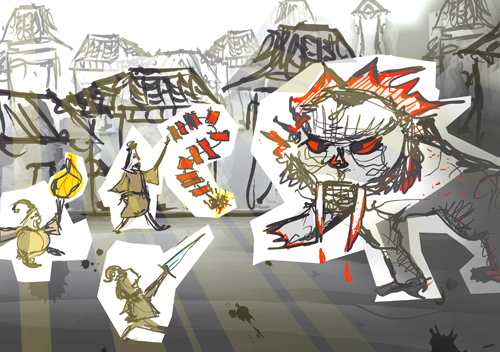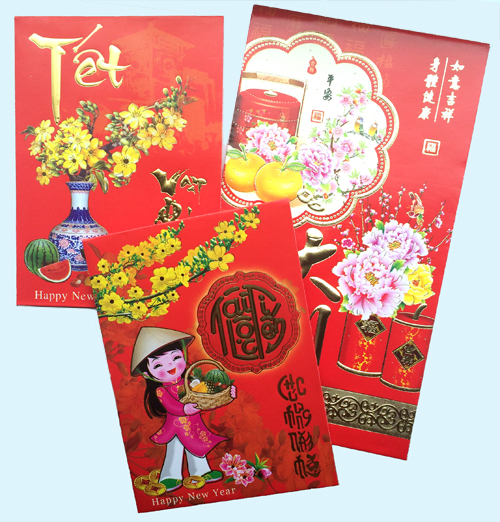By Nina Huang
Northwest Asian Weekly

“The legend of the Nian monster” (Image by Stacy Nguyen/NWAW)
Ever wondered why red is considered a lucky color during Chinese New Year? Or why people collect money in red envelopes? Chinese New Year has long been a celebration of tradition for Chinese families to bring in the new year, and many of these customs originated from fascinating Chinese folklore and stories.
University of Washington student Yushen Li grew up in China’s Guangdong province. Liu learned about the Chinese New Year traditions from family and Chinese literature. She shared the story of Nian (translates as “year”) and how this beast’s visit to a Chinese village started the new year.
The Legend of Nian
Nian slept through the year and would only visit a village every year around the same time looking for food. Villagers were scared and didn’t know what to do with him, but they knew he feared three things: the color red, fire, and loud noises.
Lijiao Serven, a Chinese instructor who hails from Liaoning, which is part of northeast China, explained that the villagers thought, “Maybe if we have all of this in the village, then the beast won’t come here.”
The villagers decorated the town with the color red, with fire everywhere, and set off fireworks to scare off the beast. They repeated the same ritual the following year, and the tradition has since been passed down from generation to generation, which was how the celebration of “Guo Nian” originated.
Because of Nian’s fears, the color red, lanterns, and firecrackers are the most common elements that one would see during the Chinese New Year celebrations.

Red envelopes 2016 (Photo by Han Bui/NWAW)
Red envelopes
Liu described getting red envelopes as the “best part of the new year.”
“Yia sui qian” or protection money was a way to bribe the Chinese gods during the new year. Older people believed that when the year changes, a god would come and take children away. Giving money to the god was a way of buying protection. Now it’s become a custom to give children money in these red envelopes.
Growing up, Serven heard a different version of the red envelope story. She said there would be a devil-like monster that would come out and touch the foreheads of children. These kids would get fevers the next day, and the parents wanted to find a way to protect their kids from the beast. The parents tried to stay up at night to protect the children, but they would fall asleep, so they put metal money under the kids’ pillows. Back then, China used metal money instead of paper.
The next day, they realized that the monster still came, but didn’t hurt the kids because of the brightness that projected from the money. And that was the story of “yia suei qian.”
“When I was little, I received money from my relatives, but since I started working, I started giving my elders money in hopes that they will have another good year,” Serven said.
Chinese New Year feasts
Feasting is one of the most important aspects of celebrating the Chinese New Year.
Liu explained that Chinese people eat dumplings during the Lunar New Year because it’s the shape of “yuan,” old Chinese money.
The Chinese translation of “jiao zi” also means “change of the year.”
She explained that on the fifth day of the New Year, people also eat dumplings, but they have to make sure some of the dumplings are left open.
“Normally you don’t want them to open them, but on the fifth day, you want a few of them to be open. This is called ‘puo wu,’” Liu said. Puo wu means to destroy anything that’s bad.
Serven said that people from the northern and southern parts of China eat different food during the Lunar New Year. She emphasized that Northeast Chinese families usually include the “must-haves,” which are dumplings, fish, and lots of meat. In Chinese, fish means surplus, and the common saying is “nien nien you yu,” which refers to having extra money year after year.
She also said that Southern Chinese folks typically eat rice cakes instead of dumplings. The rice cakes symbolize a promotion in a job or the action of moving up.
In addition, colorful candies are also a common sight during Chinese New Year. Liu explained that there’s also a tradition of leaving candies in the kitchen to appease the kitchen gods. “The reasons to put candy there is to sweeten the god’s mouth, so he won’t say anything bad when he goes to heaven,” Liu said.
Getting rid of bad spirits
People clean their homes every year because they want to get rid of bad luck, Serven said.
Liu mentioned that families also put up red banners of Chinese phrases on their doors to keep evil spirits away. For example, some people put up a picture of the god Zhong Kuei, who captures all of the devils, on the door to scare off the evil spirits. Other common signage includes one of a boy and girl, which welcomes the god of wealth into people’s homes.
Red for good luck
Wearing red continues with the tradition to keep Nian away. Also, Serven recalled that people would wear their red clothes inside out for good luck if they were born the same zodiac animal as the current year. Since there are 12 zodiac animals, superstitious people believe that your birth year could be unlucky. If one were born in the year of the monkey, then they would wear red inside out on the first day of the new year. For example, Serven explained that her parents always wore red underwear and socks inside out if it was their year. The notion behind this superstition is that you would avoid bad luck by flipping the luck around.
So if you’re feeling like you need extra luck during Chinese New Year, clean your house, wear bright red colors, eat lots of fish and dumplings, and don’t be afraid to indulge in some candy. (end)
Nina Huang can be reached at info@nwasianweekly.com.



